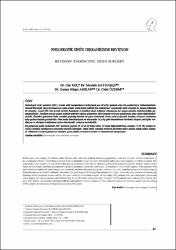| dc.contributor.author | Koç, Can | |
| dc.contributor.author | Kaymakçı, Mustafa | |
| dc.contributor.author | Arıkan, Osman Kürşat | |
| dc.contributor.author | Özdem, Cafer | |
| dc.date.accessioned | 2020-06-25T14:45:45Z | |
| dc.date.available | 2020-06-25T14:45:45Z | |
| dc.date.issued | 2001 | |
| dc.identifier.citation | Koç, C., Kaymakçı, M., Arıkan, O. K., Özdem, C. (2001). Endoskopik sinüs cerrahisinde revizyon. Kulak Burun Boğaz ve Baş Boyun Cerrahisi, 9(2), 83 - 87. | en_US |
| dc.identifier.issn | 1300-6525 | |
| dc.identifier.issn | 2149-0880 | |
| dc.identifier.uri | https://app.trdizin.gov.tr/publication/paper/detail/TVRRM09ERXg= | |
| dc.identifier.uri | https://hdl.handle.net/20.500.12587/1102 | |
| dc.description.abstract | Endoskopik sinüs cerrahisi (ESC), kronik sinüs hastalıklarının tedavisinde son 20 yıldır giderek artan bir popülariteyle kullanılmaktadır. Normal fizyolojik yapıyı korumaya en yakın teknik olarak kabul edildiği için fonksiyonel endoskopik sinüs cerrahisi de yaygın kullanılan bir tanımdır. Ancak ESC tüm kronik sinüzitli hastalarda ve özellikle nazal polipozis vakalarında her zaman istenilen fonksiyonelliğe ulaşamamaktadır. Ameliyat sonrası uygun medikal tedaviye rağmen şikayetleri süren hastalar revizyon ameliyatına aday olarak değerlendirilmelidir. Önceden geleneksel sinüs cerrahisi geçirmiş hastalar bir yana bırakılacak olursa nazal polipozisli hastalar, revizyon cerrahisine aday grubun başında gelmektedir. Orta konka laterallzasyonu ve adezyonlar ile polip gibi etmoidektomi kavitesini tıkayan patolojiler ventilasyon ve drenajın bozulmasına neden olan önemli revizyon nedenleridir. Bu çalışmada çeşitli nedenlerle ESC ameliyatı geçiren ve 12-20 ay takip edilen 50 hasta değerlendirilmiş, sonuçta 14 (% 28) hastaya revizyon cerrahisi endikasyonu konularak ameliyat edilmiştir. Takip süresi uzadıkça revizyon gerektiren hasta sayının arttığı dikkat çekmiştir. Makalede revizyon gerektiren vakaların genel analizi, revizyon kriterleri ve zamanlaması tartışılmıştır. | en_US |
| dc.description.abstract | Endoscopic sinus surgery for chronic sinus diseases, has been used with an increasing popularity in the last 20 years. As it is considered to be a technique which is most likely to preserve the normal physiology, the term 'functional endoscopie sinus sur-gery' is widely accepted. Yet, endoscopie sinus surgery can not achieve that goal in all patients with chronic sinusitis, particu-larly in nasal polyposis. Patients whose complaints persist despite maximal postoperative medical treatment, should be consi-dered as candidates for revision surgery. If the patients who had underwent traditional sinus surgery are excluded; patients with nasal polyposis constitute the main candidate group for revision surgery. Lateralisation of the middle turbinate, adhesions, and pathologies like polyps that obstruct of cavity ethmoidectomy disrupt ventilation and drainage of the paranasal sinuses and are the main reasons for revision surgery. In this study, fifty patients who had undergone endoscopie sinus surgery for various reasons and followed for 12 to 20 months were evaluated. Fourteen (%28) patients were selected for revision surgery. The fol-low- up duration correlated with the indication for revision surgery. In this paper the reasons for revision surgery and the timing of the surgery are discussed with general analysis of the cases. | en_US |
| dc.language.iso | tur | en_US |
| dc.rights | info:eu-repo/semantics/openAccess | en_US |
| dc.subject | Kulak, Burun, Boğaz | en_US |
| dc.title | Endoskopik sinüs cerrahisinde revizyon | en_US |
| dc.title.alternative | Revision endoscopic sinus surgery | en_US |
| dc.type | other | en_US |
| dc.contributor.department | Kırıkkale Üniversitesi | en_US |
| dc.identifier.volume | 9 | en_US |
| dc.identifier.issue | 2 | en_US |
| dc.identifier.startpage | 83 | en_US |
| dc.identifier.endpage | 87 | en_US |
| dc.relation.journal | Kulak Burun Boğaz ve Baş Boyun Cerrahisi | en_US |
| dc.relation.publicationcategory | Diğer | en_US |
















